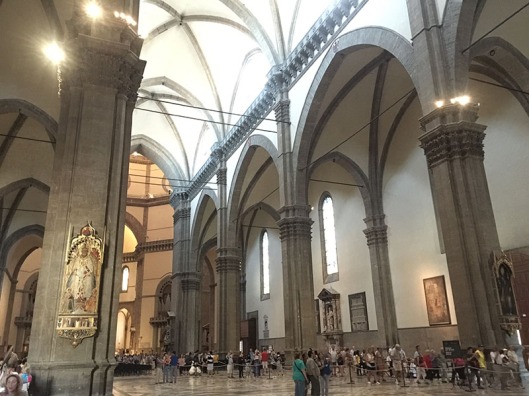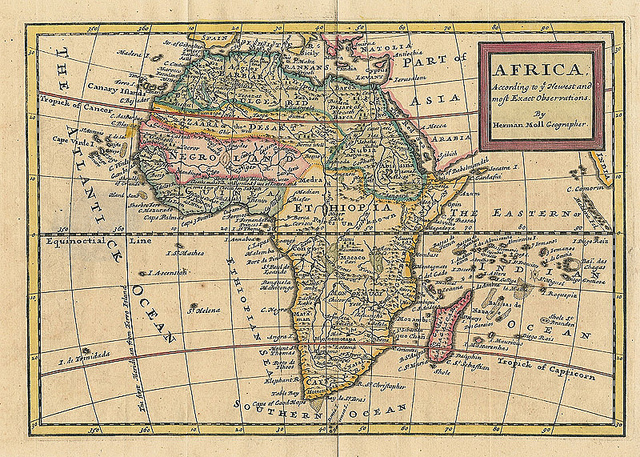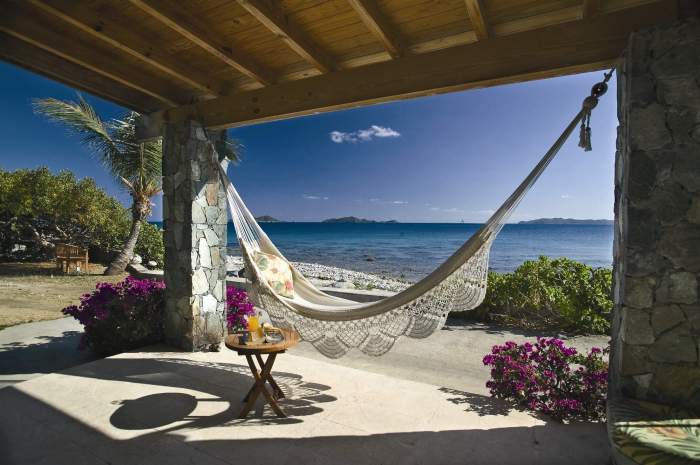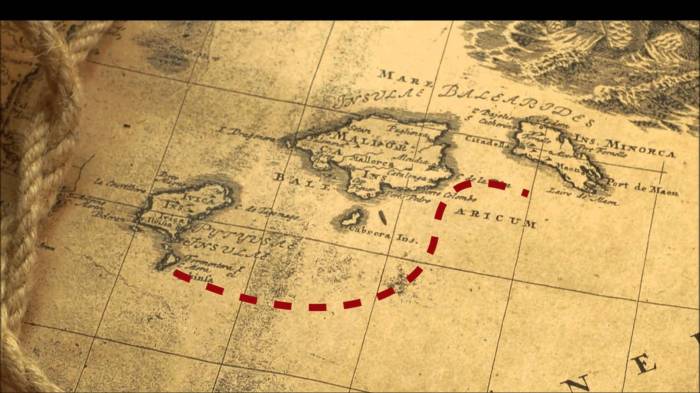
If you ever visit, you may not have a month to explore the city like we did, but maybe some of the things we did can help you make decisions about how to spend your time. We have visited more places then we described below, but these have been the high points so far.
Of course during our stay in Florence we wanted to see all “the big things.” We had the luxury of not feeling rushed, and we managed to check everything off our list.
First, let’s talk about the stuff downtown
Six of the most renown sites are collectively referred to as “The Florence Duomo Complex.” These sites consist of:
- Giotto’s Bell Tower – affording an amazing view of the Florentine city and countryside
- The Cathedral Santa Maria del Fiore – amazing and immense gothic basilica
- Brunelleschi’s Duomo – an amazing rotunda atop the cathedral
- The underground archeological site below the Cathedral, Santa Reparata
- The Baptistry, a large domed building across from the Cathedral
- the Opera del Duomo Museum
We bought a combo ticket for all of these sites for 15 Euros, a great deal for what you see. You can buy the ticket online here, but we bought ours in person at the base of the Bell Tower, in an office that opened at 8am.
A note about the combo ticket – it’s good for 7 days after you purchase it, but once you validate it at the first site on the list above, you have 48 hours to see all the sites before the ticket expires. Plan accordingly.
The ticket allows you to stand in the general admittance line for each of these sites. For the Cathedral and the Duomo ( the Dome ) we recommend you show up early, on different days. These lines get crazy-long very quickly. These two sites open at 830am, and we were in line for our visit to the Duomo by 745am with a very comfortable position, almost first. We splurged and spent 15 ( additional ) Euros apiece to see the Cathedral with a guided tour that enabled up to bypass the huge line.
A note about the Bell Tower and the Duomo: if you’re a little claustrophobic like I am, I can’t recommend strongly enough the importance of arriving early for the ascents of the Duomo and the Bell Tower. Both of these sites involve walking up serious stairs in very cramped passageways. If you are near the front of the line in the morning for these sites, this insures that after you ascend to the top and look around you can descend back to street level without pushing up against a mass of sweaty people in a cramped passage.
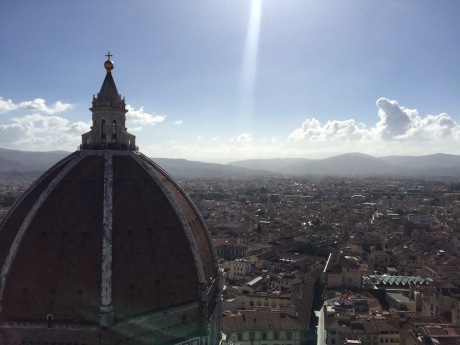
As I walked past the seriously long line at 2pm in the sweltering sun this afternoon, I hope these poor people -love- what they are going to see, for they are surely suffering for the opportunity. Baking in the hot sun for 3 hours, then squeezing past their sweaty neighbors for a dizzying climb is not my idea of a good time on vacation.
That being said, the views are amazing, inside ( the Duomo ) and out. But the tight spaces… ugh. Rough for me. The Duomo in particular.
Also, there’s this – the Duomo and the Bell Tower afford amazing views, but if you’re at all afraid of heights, these attractions probably aren’t for you.
The Bell Tower also has a line at times, but this seemed to vacillate during the day. We went early the first day, buying our tickets and seeing the Bell Tower with no line, then as I’ve mentioned spent the additional 15 Euros to jump the line for the Cathedral ( and the crypt Santa Reparata ), and then the next day got in line early for the climb up to the top of the Duomo.
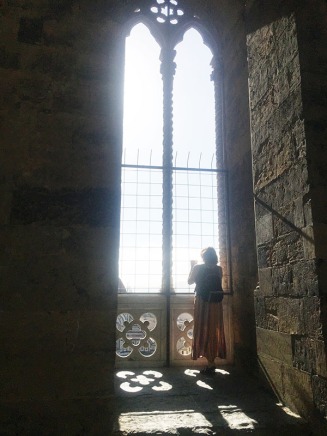
The Baptistry has no line to speak of, nor does the Opera del Duomo Museum, which are both really a neat experiences. At the Museum you see up close many pieces that were made for and once a part of the Cathedral.
Other sites
We purchased tickets separately to see Michelangelo’s David in the Academia Gallery. We recommend spending a little extra and getting the time stamped version of these tickets. Also, if you buy tickets online make sure you get printed out versions from the little kiosk across the street from the entry. Ugh.
Getting here early probably helps, but our stamped time was for 545pm. We stood in line for about half hour and made it in almost exactly at our scheduled time.
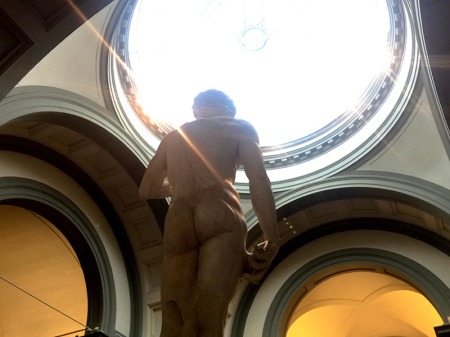
Our favorite spot for gelato was “La Milkeria” with their homemade masterpieces, perfect on a hot day.

We didn’t have a favorite spot for wine or cappuccino; there were too many perfect places everywhere we looked.
Our favorite place to laptop and do a little work was The Cafeteria delle Oblate, near The Duomo. It’s not like any cafeteria you’ve ever been to – it’s an amazing multi-level open air space with great food, wine and other drinks and free wifi. It’s frequented by students and tech workers, and really is a pretty sweet spot, with a view of the Duomo.
We took a day tour to Pisa to see the leaning tower and the local cathedral. The same tour brought us to the amazing Tuscana World Heritage site of San Gimignano, and the city of Siena. If we had to do it all over again, for the timing of this tour… It would have been perfect to spend a few hours in Pisa and a few hours in Siena, and another tour to spend all day at San Gimignano. But we got amazing pictures.
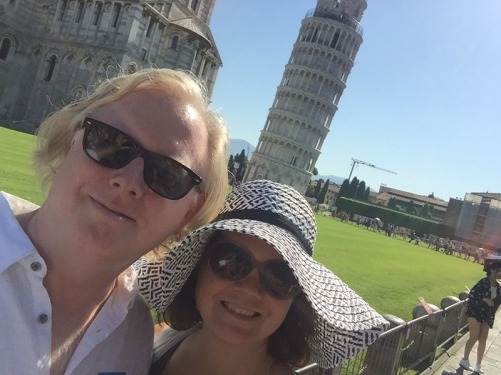
For our place – we stayed at an AirBnB right near the Talenti tram stop, about a 40 minute walk from the Florence city center and it seemed like a perfectly fine option. neighborhood markets and lovely people, as we’ve detailed elsewhere. This put us close to the amazing park just north of the Arno river and west of downtown Florence.

We rented bikes at the SMN train station ( the main one in Florence city center ) for a day for 10 Euros apiece. The bikes were nothing special, but we had an amazing day going through this park in the morning and through Florence itself later on. There is also a bike route that circumscribes old Florence, but there’s really very little to see along this route. We recommend taking your bike into Old Florence despite the crowds, and possibly across the river at Ponte Vecchio.
Those are the highlights that we haven’t discussed elsewhere on the blog. We have a week left and we will try and see a jousting, a concerto, and a few other things before we wrap our stay up. If you have any must-sees, let us know.
